When making soap at home, you'll need essential protective gear including safety goggles with ANSI Z87.1 compliance, chemical-resistant nitrile gloves, and respiratory protection for lye fumes. Don't forget to wear long sleeves, pants, and a waterproof apron to prevent skin exposure. Set up an eyewash station and keep a first aid kit nearby for emergencies. Proper spill containment tools and heat-resistant surfaces complete your safety setup for worry-free crafting.
Must-Have Protective Equipment for Making Soap at Home
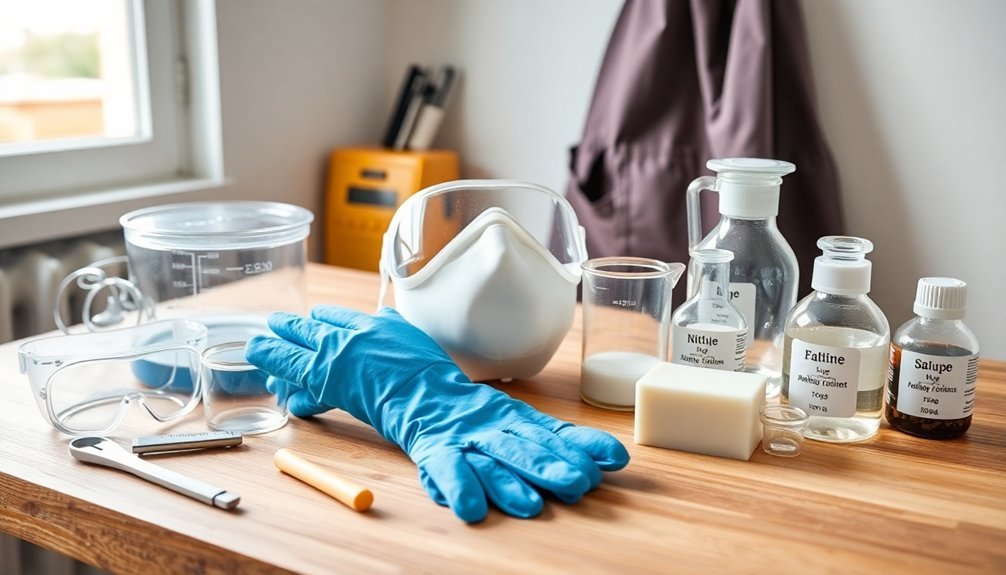
Five essential pieces of protective gear stand between you and potential harm when making soap at home.
Safety goggles are non-negotiable, shielding your eyes from lye solution splashes and raw soap batter that could cause serious damage.
Don't overlook nitrile gloves, which provide superior puncture resistance while accommodating those with latex allergies.
When mixing lye, a full-face respirator offers vital protection from harmful fumes that can irritate your respiratory system.
Always wear long sleeves and pants to prevent skin exposure to caustic ingredients. This simple personal protective measure greatly reduces risk during the soap-making process.
Finally, secure your hair with a hairnet to maintain hygiene and prevent contamination in your finished products.
These precautions aren't just suggestions—they're essential safeguards for your soap-making journey.
Essential Eye Protection: Goggles and Face Shields
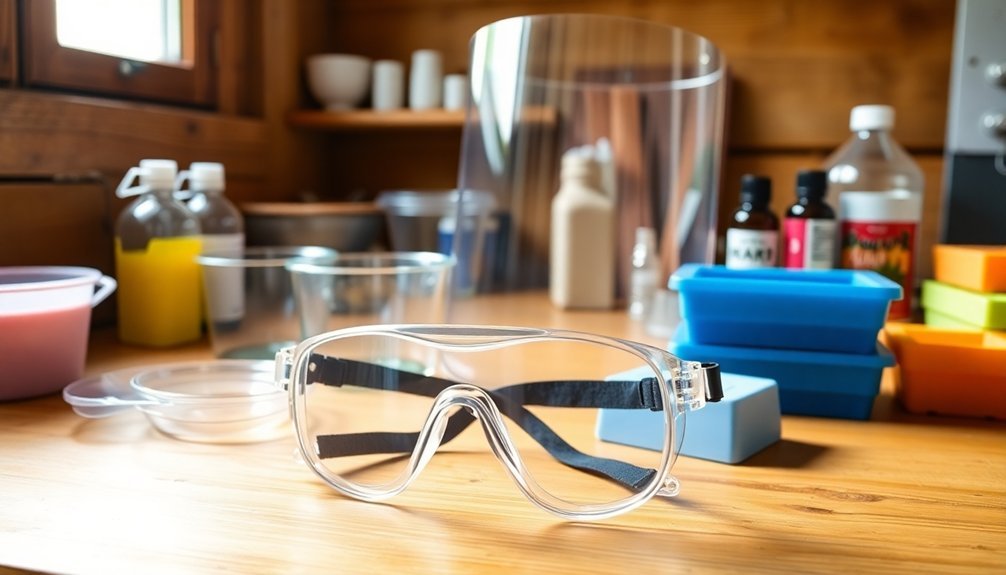
When making soap at home, you'll need proper eye protection since regular glasses won't provide adequate coverage against caustic lye splashes.
Safety goggles create a complete seal around your eyes, preventing dangerous chemicals from reaching your sensitive eye area during the soap-making process.
For maximum protection, you can opt for a full-face shield that guards both your eyes and face from harmful splashes and fumes.
Safety Goggles Vs Glasses
Why risk your vision when making soap at home? Regular glasses simply don't offer the protection you need when working with lye and raw soap.
Safety goggles create a sealed barrier around your eyes, preventing chemical splashes from causing serious injury. Unlike glasses, properly fitted goggles block harmful particles and vapors generated during the soap-making process.
Always choose goggles that comply with ANSI Z87.1 standards to guarantee effective protection.
For larger batches, consider full face shields for additional coverage beyond your eyes. These provide thorough protection against unexpected splashes or spills.
Remember to inspect your eye protection regularly for damage or wear. Even small cracks or loose fittings can compromise the safety they provide.
Your vision is irreplaceable—don't compromise on proper eye protection.
Full-Face Shield Benefits
Full-face shields take your soapmaking safety to the next level, offering protection beyond what safety goggles alone can provide.
When working with lye solution, these shields create a complete barrier between your entire face and potentially damaging splashes from raw soap batter.
For maximum protection, wear a full-face shield in conjunction with safety goggles. This combination shields you from both chemical splashes and harmful fumes released during the mixing process.
The extensive coverage helps mitigate serious soapmaking hazards associated with high concentrations of oils and chemicals.
As an added benefit, full-face shields are easy to clean and reuse, making them a cost-effective addition to your protective equipment arsenal.
Don't compromise on eye protection—a properly fitted shield could prevent serious injuries that might otherwise occur during your soapmaking projects.
Hand and Arm Safety: Chemical-Resistant Gloves
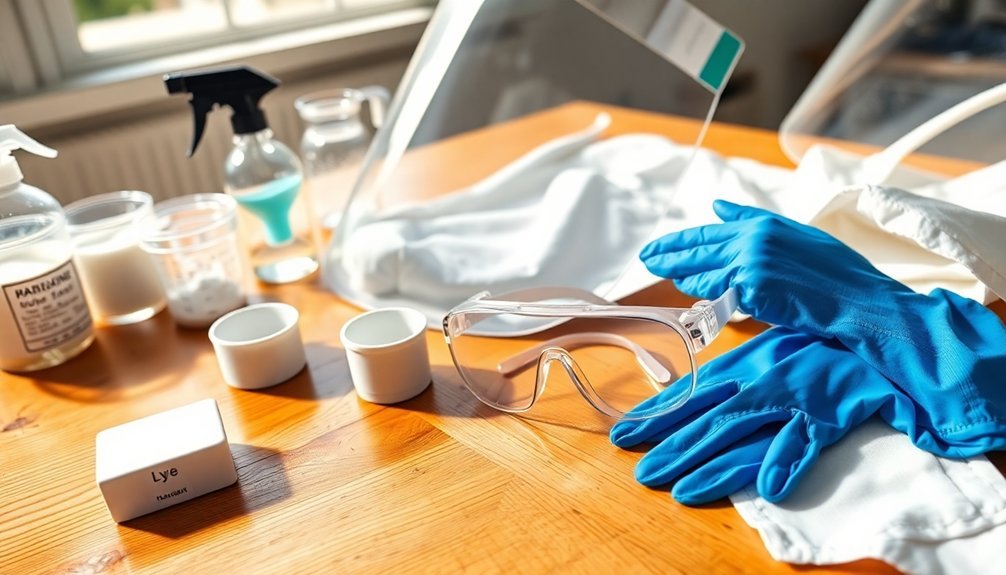
Your hands and arms face the greatest exposure risk during soap making, making chemical-resistant gloves your most critical protective gear. Nitrile gloves provide essential protection from lye's corrosive nature while you craft soap safely. These FDA-compliant gloves offer puncture resistance and reliable chemical barriers.
Always select gloves that fit properly to prevent any accidental lye contact with your skin. Regular inspection for wear or damage guarantees continued protection throughout your soapmaking journey.
| Glove Type | Benefits | Recommended Use |
|---|---|---|
| Nitrile | Puncture resistant | Heavy lye handling |
| Medium Size | Snug fit for detail work | Precise measurements |
| Large Size | Easy on/off | General soap making |
| Bulk Packs | Cost effective | Frequent soap makers |
Respiratory Protection: Masks and Ventilation Systems
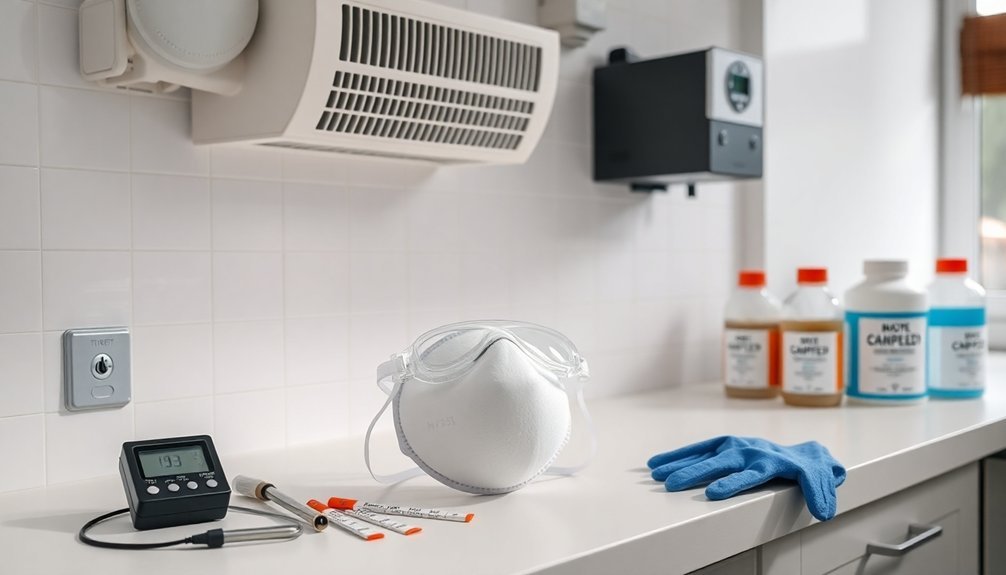
While protecting your hands with proper gloves forms the foundation of soap making safety, safeguarding your respiratory system demands equal attention.
When mixing lye, you'll generate harmful fumes and particles that can cause serious respiratory issues with repeated exposure.
Invest in a full face shield respirator with replaceable cartridges specifically designed to filter VOCs. This dual-purpose equipment protects both your airways and facial skin from potential splashes.
Don't rely solely on masks—improve your workspace air quality by installing a counter fan or exhaust system to disperse fumes effectively.
Remember to wear your respiratory protection whenever handling lye solutions or adding fragrances.
Regularly check and replace your respirator filters to maintain ideal protection levels.
Your lungs will thank you for taking these ventilation systems and respiratory safeguards seriously.
Protective Clothing: Aprons and Long Sleeves
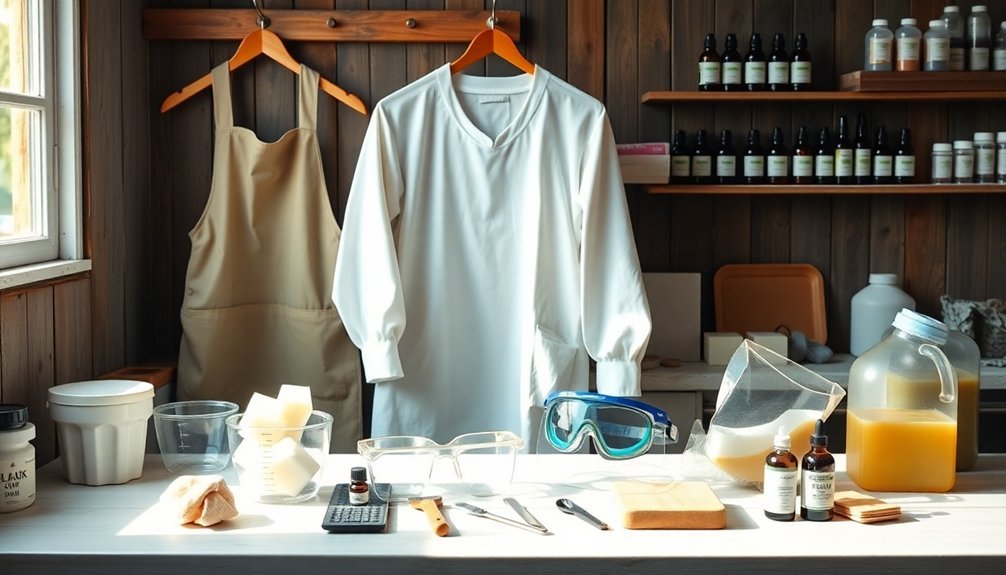
Proper protective clothing serves as your second line of defense against the hazardous materials used in soap making. An apron made from non-absorbent materials will shield your clothing from lye splashes and soap batter, creating a cleaner workspace while preventing contamination.
When selecting your protective clothing, focus on:
- Long sleeves that completely cover your arms from potential lye exposure
- A dedicated apron that won't absorb corrosive materials
- Comfortable, secure-fitting items that won't shift during soap production
- Regularly inspected gear free from damage or wear
Don't underestimate the importance of proper coverage—lye can cause severe skin irritation and burns if it contacts unprotected areas.
Your protective clothing should fit well while allowing enough movement for you to work safely and efficiently.
Emergency Response Tools: First Aid and Eyewash Stations
Even the best protective clothing can't guarantee complete safety in soap making. You'll need a well-stocked first aid kit containing adhesive bandages, antiseptic wipes, and burn cream to address injuries immediately. Check regularly that supplies haven't expired.
An eyewash station is non-negotiable when working with lye. Position it within easy reach of your workspace, ensuring it provides continuous water flow for at least 15 minutes—crucial if chemicals splash despite wearing safety glasses.
Train everyone in your household on emergency response procedures, including the proper handling of lye spills (rinse with water, never neutralize with vinegar).
Even when wearing dishwashing gloves, accidents can happen, so preparation is essential. Make the locations of your first aid kit and eyewash station known to all who enter your soap-making area.
Workspace Safety Equipment: Heat-Resistant Surfaces and Spill Containment
Your soapmaking workspace needs heat-resistant surfaces like stainless steel or tempered glass to withstand the high temperatures involved in the process.
You'll want to include spill containment measures such as absorbent mats or trays to catch any lye or oil spills and make cleanup easier.
Keep emergency response tools within reach, including a basic spill kit with granular absorbent to quickly address accidents before they become hazards.
Heat-Resistant Workspace Options
While making soap involves numerous safety precautions, creating a heat-resistant workspace forms the foundation of your protection strategy.
Your soapmaking workspace needs to withstand both high temperatures and corrosive substances like lye.
Choose from these reliable options to protect countertops and equipment:
- Stainless steel surfaces – Provide excellent heat resistance and won't react with corrosive substances, making them ideal for regular soapmakers.
- Tempered glass boards – Offer a smooth, non-reactive surface that's easy to clean after spills.
- Silicone baking mats – Create a flexible, heat-resistant barrier that can be removed and washed.
- Heat-resistant trays or bins – Contain potential spills while providing an organized work area.
Regularly inspect these surfaces for damage to maintain a safe environment for your soapmaking activities.
Spill Containment Strategies
Heat-resistant surfaces form only part of your workspace safety equation—equally important is how you'll manage inevitable spills during soapmaking.
Implement spill containment strategies by placing absorbent mats or trays underneath your mixing area to catch errant drops of lye solution or oils before they create hazards.
Keep a dedicated spill kit within arm's reach, stocked with absorbent materials and cleaning supplies for quick response to accidents.
Create a designated area for mixing lye and soap batter, ideally with raised edges or barriers that prevent liquids from spreading across your workspace.
Regularly inspect your containment systems for wear and potential hazards that might compromise their effectiveness.
This proactive approach to spill management isn't just about cleanliness—it's fundamental to safe soapmaking and protects both you and your surroundings from caustic materials.
Emergency Response Tools
Even with careful preparation, emergencies can occur during soapmaking, requiring immediate and appropriate response capabilities in your workspace.
Having the right emergency response tools ready can make the difference between a minor incident and a serious accident.
- Spill containment tools – Keep absorbent pads and dedicated spill kits within arm's reach to quickly address any splash of lye or oil spills.
- First aid supplies – Stock burn treatment materials and eye wash solution for immediate care.
- Labeled emergency equipment – Verify all tools are clearly marked and accessible for rapid response.
- Cleanup procedure guide – Post step-by-step instructions for managing different types of spills (remember: don't neutralize lye with vinegar).
Regularly inspect and replace these materials to protect your workspace and confirm they remain effective when needed most.
Frequently Asked Questions
What Protective Equipment Is Needed for Soap Making?
You'll need safety goggles, nitrile gloves, a respirator mask, long sleeves, long trousers, an apron, and hairnets when making soap. These protect your eyes, skin, lungs, and maintain hygiene during the process.
What Precautions Should Be Taken When Making Homemade Soap?
When making homemade soap, you'll need to wear safety goggles, a respirator, chemical-resistant gloves, and protective clothing. Always work in a well-ventilated area and keep a first aid kit handy for emergencies.
What Equipment Do I Need to Make Homemade Soap?
To make homemade soap, you'll need mixing bowls, a digital scale, silicone molds, thermometer, immersion blender, measuring spoons, lye, oils, and essential oils for fragrance. Don't forget safety gear like goggles and gloves.
What Are the Safety Precautions for Soap Making?
Always wear elbow-length rubber gloves, safety goggles, and long sleeves when handling lye. You'll need proper ventilation, non-aluminum equipment, and a first aid kit nearby. Never leave chemicals unattended around children or pets.
In Summary
Don't compromise your safety when making soap at home. You've now got the essential protective gear checklist: proper eye protection, chemical-resistant gloves, respiratory safeguards, protective clothing, emergency response tools, and workspace safety equipment. When you're fully equipped, you'll enjoy your soap-making hobby with confidence and peace of mind. Remember, the right protective equipment isn't optional—it's your first line of defense against potential hazards.

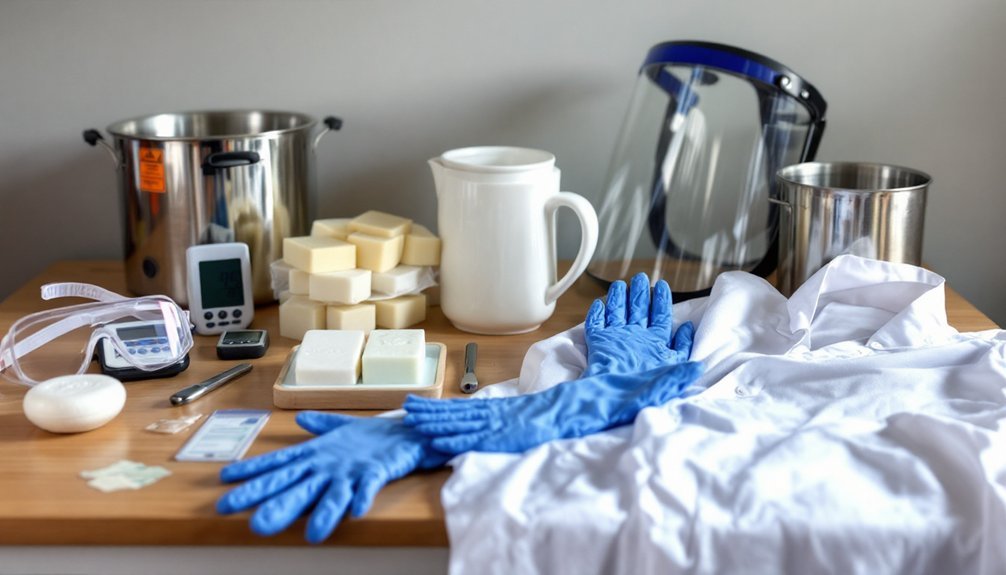



Leave a Reply